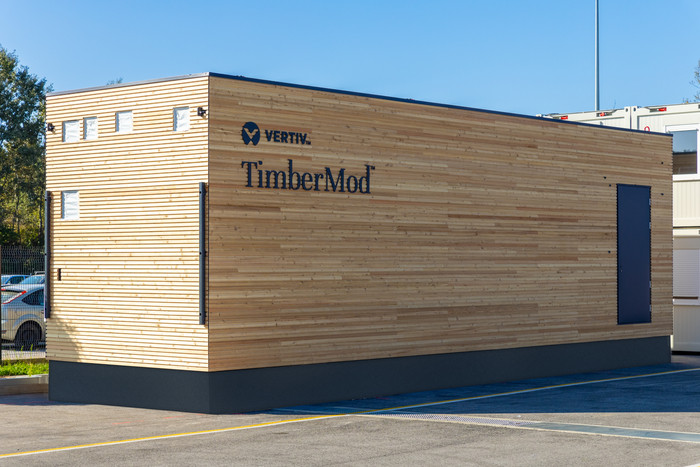Vertiv Launches Sustainable Wooden Data Center SolutionVertiv Launches Sustainable Wooden Data Center Solution
Are wooden data centers the future of sustainable design? Vertiv is betting on it with the introduction of TimberMod, a modular data center solution made mostly of timber. Here, we take a look at TimberMod and what wooden data centers have to offer.

Vertiv, the US-based manufacturer of turnkey digital infrastructure solutions, has launched a modular wooden data center concept that’s aimed at helping organizations reduce their carbon footprint and meet their sustainability goals.
Issues surrounding sustainability in the data center industry are becoming increasingly important. In the US alone, demand for data centers is forecast to grow by 10% a year until 2030. This increased demand will necessitate the construction of more data centers – facilities that are often primarily composed of non-renewable resources including steel and cement.
In an effort to address this key issue and help its customers meet their sustainability objectives, Vertiv has launched TimberMod, a new data center concept that features timber as a key structural component.
Available as a construction option for its Power Module and SmartMod range of prefabricated modular data centers, the eco-friendly TimberMod solution meets applicable structural requirements and provides “robust performance in the face of seismic activity, wind forces, and structural demands.”
“We are dedicated to finding innovative solutions that can help reduce data center carbon footprints through the use of environmentally friendly construction materials and processes,” said Viktor Petik, vice president and EMEA leader for Vertiv’s Integrated Modular Solutions business.

TimberMod modular data centers are created using sustainably harvested wood.
Discussing the development of the new solution, Vertiv architect Ela Ptiček told Data Center Knowledge: “This innovative solution emerged as a direct response to the voice of our customers who have expressed interest in reducing their environmental impact and carbon footprint. Our customers requested a solution that could meet the robust technical requirements for data centers but also addressed the imperative of reducing their ecological footprint.”
‘Grow Your Own Data Center’
Although wooden data centers might seem like a radical concept, Vertiv is not the first company to have made use of timber as a primary component for IT facilities.
In 2019, colocation provider EcoDataCenter opened one of the world’s most sustainable data centers, EcoDataCenter 1 in Falun, Sweden. In addition to running on 100% wind and hydropower, the data center is constructed primarily out of wood – or, more specifically, cross-laminated timber (CLT).
According to Mikael Svanfeldt, chief technology officer at EcoDataCenter, the future has already arrived, and the main task at hand is to educate those in the industry who might be averse to using timber as a primary construction material.
“In the Nordics, we have a thousand-year legacy of using wood as a construction material,” Svanfeldt told Data Center Knowledge. “There are a lot of buildings in Sweden that are built using CLT – hotels airports, apartments, and other residential buildings.”
“EcoDataCenter was formed by a group of entrepreneurs who saw that the ICT industry was booming and that sustainability would become important to the industry. They knew we needed to overcome the legacy of building with concrete and steel.”
Fire Safety
With cement production now said to account for around 8% of global carbon emissions, timber buildings sourced from sustainably harvested wood may indeed represent the future of data center design. But what about fire safety – is wood a suitable material for housing servers and other power-hungry equipment?
“Cross-laminated timber has totally different characteristics to normal wood,” said Svanfeldt. “It is actually self-extinguishing due to the lamination. Our designs are all EI90-rated, which means they can withstand a fully developed fire for 90 minutes.”
The fire-resistant capabilities of timber data centers were echoed by Vertiv architect Ptiček echoed the fire-resistant capabilities of timber data centers.
“Our solution provides for the encapsulation of the structure. This method aligns with established safety standards, such as Eurocode 5, and is recognized as an acceptable practice in building codes. This approach provides for minimal contribution of the structural components to the fire risk, meeting stringent fire rating requirements (e.g., EI60, EI90, EI120).”
Sustainable Future
As the European Commission develops a comprehensive roadmap to reduce the whole-life carbon of the building sector by 2050, Ptiček thinks TimberMod is well placed to help the data center industry meet its sustainability targets.
“Timber data centers are not new, but they have become much more accessible now that a major prefabricated modular data center vendor offers data center building blocks or an entire data center building built with timber,” said Vladimir Galabov, research director at Omdia’s cloud and data center unit.
“Prefabricated data centers can already shorten build time by 40-80%. The initial indication is that prefabricated modules made of timber are quicker to build than their steel or composite material alternatives, further shortening build time. It’s time to open our minds and embrace this solution which can reduce a data center building’s carbon footprint by two-thirds.”
When it comes to renewable and sustainable design, Svanfeldt of EcoDataCenter said heavily forested countries like Sweden are the ideal places to drive innovation in the field.
“We are investing to double our capacity at EcoDataCenter 1 and have a new EcoDataCenter 2 site coming up in Östersund coming,” he said. “Our main facility features 3,200 cubic meters of wood. It takes the Swedish forest just 14 minutes to grow the same amount of timber, which demonstrates just how renewable wood can be as a construction material.”
About the Author
You May Also Like









